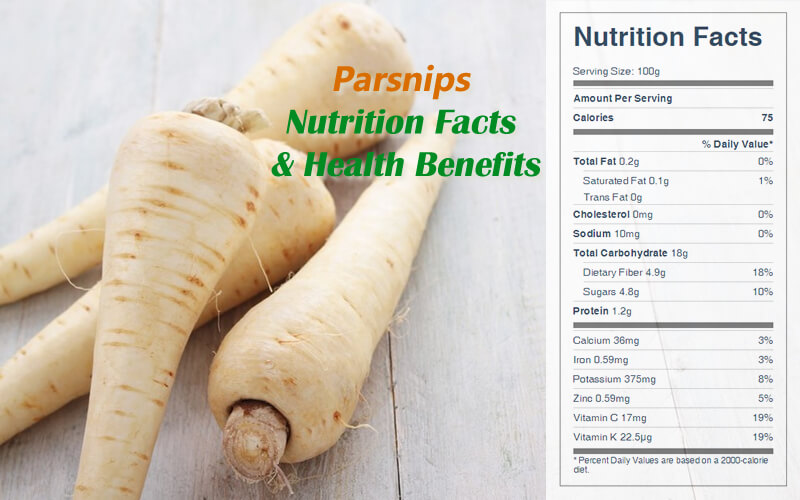Parsnips Nutrition Facts & Health Benefits
The parsnip is a root vegetable closely related to carrots and parsley. Parsnips are high in vitamins, antioxidants, and minerals and also contain both soluble and insoluble dietary fiber. Here are the nutrition facts and health benefits of parsnips.
Parsnips are an excellent source of vitamin C, folic acid, pantothenic acid, copper, manganese, and fiber. They also provide vitamin E; the B vitamins niacin, thiamine, riboflavin, and B6; and the minerals magnesium and potassium.

The nutritional value of parsnip
Most parsnip cultivars consist of about 80% water, 5% sugar, 1% protein, 0.3% fat, and 5% dietary fiber. The parsnip is rich in vitamins and minerals and is particularly rich in potassium, with 375 mg per 100g. Several of the B-group vitamins are present, but levels of vitamin C are reduced in cooking.
One-half cup of boiled parsnips provides 63 calories, 15.2 g carbohydrate, 1 g protein, 0.2 g fat, 3.1 g dietary fiber, 10 mg vitamin C, 45 mcg folic acid, 286 mg potassium, 8 mg sodium, 54 mg phosphorus, 29 mg calcium, and 23 mg magnesium.
Parsnips Nutrition Facts Label
Health Benefits of Parsnips
Parsnips are lower in calories and provide only about half as much protein and vitamin C as potatoes, but they contain more fiber and folic acid. Although closely related to carrots, they lack beta-carotene and, consequently, the orange color. Parsnips provide more potassium than carrots.
The consumption of parsnips has potential health benefits. They contain antioxidants such as falcarinol, falcarindiol, panaxydiol, and methyl-falcarindiol, which may potentially have anticancer, anti-inflammatory, and antifungal properties.
Parsnips benefit our immunity and our gut health. They are high in fiber, providing a positive benefit to our gut microflora. They have a positive impact on disease management and prevention.The dietary fiber in parsnips is partly of the soluble and partly of the insoluble type and comprises cellulose, hemicellulose, and lignin. The high fiber content of parsnips may help prevent constipation and reduce blood cholesterol levels.
The most important active ingredient found in parsnips—and a key differentiator between them and their carrot cousin—is the presence of furanocoumarins. The most important furanocoumarins are xanthotoxin, bergapten, isopimpinellin, angelicin, psoralen, sphondin, and imperatorin.
Furanocoumarins possess antiproliferative effects, which makes them useful in treating diseases such as psoriasis. These antiproliferative properties also translate to the anticancer effect observed in breast, colon, and prostate cancer. The high concentration of coumarins in parsnips can inhibit the growth of these cancer cells. Furanocoumarins also play a role in increasing our cytochrome P450 enzymes, which are the primary enzymes responsible for metabolizing toxins to be removed from the body.
Apigenin is found in abundance in parsnips. It serves as an antioxidant that provides therapeutic benefits to overcome diseases with an inflammatory potential, such as autoimmune disease, neurodegenerative disease, and cancer. It plays a direct role in killing cancer cells. In human cell cultures, apigenin has been found to inactivate NF-kB by suppressing lipopolysaccharide (LPS). From an antioxidant standpoint, it also enhances the expression of antioxidant enzymes GSH, CAT, and SOD, making it a key contributor to the antioxidant potential of parsnips.
Parsnips are usually cooked, but can also be eaten raw. It has a sweet flavor, not unlike carrots; they taste best after the first hard frost of winter.
Parsnips look like carrots, but they are often larger and have a pale golden color. Parsnips need to be peeled before cooking; if they have gained a woody core, trim it away.
Store parsnips in the refrigerator in a perforated plastic bag, but don’t wash them before storing. They will keep them for four to five weeks. You can also freeze them. The parsnips are washed, trimmed, and peeled, then cut into chunks. Drop the chunks into the boiling water and boil for three minutes. Remove them from the pot and cool them under cold water to stop the cooking. Drain them well, and pack them in plastic zipper bags.
Parsnips are among the tastiest vegetables. They can be baked, boiled, pureed, roasted, fried, grilled, or steamed. Try mixing parsnips with an equal number of carrots. Mash them together with rutabagas, carrots, or potatoes, or brush them with a little oil and roast. They’re even fabulous cooked on the grill.
When used in stews, soups, and casseroles, they give a rich flavor. In some cases, parsnips are boiled and the solid portions are removed from the soup or stew, leaving behind a more subtle flavor than the whole root and starch to thicken the dish. Parsnips can also be fried or thinly sliced and made into crisps.
Health Risk
It is worth paying attention to furanocoumarins when taking medication: They are found in citrus fruits, particularly grapefruit. Grapefruit juice can interact with certain medications that are metabolized through this cytochrome P450 pathway, and research has confirmed that it’s the furanocoumarins that cause this interaction, not the grapefruit juice alone. Parsnips could create a similar response!